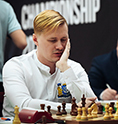16 April 2017
Honoring Korchnoi With All or Nothing Play Only!
Zurich Supertournament opening ceremony in the review of Vladimir Barsky.
They say that Space Exploration Day had winter return to Moscow, while Zürich met its guests with what looked like a spell of summer weather as every other passer-by that came our way had T-shirts on and were no longer wearing jackets or any other warm clothing. Edition six of the Zürich Chess Challenge is being carried out in loving memory of a great chess warrior Viktor Lvovich Korchnoi. He used to attend each year's opening ceremony in the company of his wife Petra, whereas two years ago he even had a friendly match with Wolfgang Uhlmann staged at the Savoy Hotel. While putting all his heart into the game, as was only natural with him, he still managed to find fault with something to grow somewhat emotional. He was a man who could not imagine his life without chess...Korchnoi and chess
Running in parallel with this year's main tournament will be a strong open, both taking place at the Congress Hall that used to host the famous 1953 Candidates Tournament (or, rather, part of it, to be more precise). As tradition has it, the opening ceremony took place in the luxurious hotel Savoy. Meanwhile, it was by a couple of hours prefaced with an exhibition game between the event's sponsor Oleg Skvortsov and Vishy Anand. The Ex-world Champion had 15 minutes versus sponsor's 30 and a 5-second increment per move.
Skvortsov – Anand
Giuoco Piano
1.e4 e5
Four years ago Zürich saw same opponents play a friendly game, but back then Anand opted for the Sicilian Defence.
2.Nf3 Nc6 3.Bc4 Bc5 4.c3 Nf6 5.d4 exd4 6.b4!?
This is a very rare move. Skvortsov is true to his style, essaying to get his opponent out of book as early as possible and not minding sacrifice of material in return for some initiative.
6…Bb6 7.e5 d5 8.exf6
A modest retreat 8.Bb3 looks no good in view of 8…Ne4 9.cxd4 Bg4 10.Be3 0–0 (also good is 10...Nxb4) 11.h3 Bh5 12.g4 Bg6 13.a4 a6 14.h4 h6 15.h5 Bh7 16.a5 Ba7 17.Ra4 f6, and Black switches to the offensive, as in Ciruzzi – Garcia Palermo, Mar del Plata 2014.
While commenting the game online with Mark Glukhovsky, I proposed 8.Bb5. However, nothing good comes of it for White after 8…Ne4 9.cxd4 0–0 10.Bxc6 bxc6 11.0–0 f6, and Black takes over.
8...dxc4 9.Qe2+
9.b5 is strongly met by 9…0–0! (9...Na5 is in an old game Honfi – Dueckstein played in the 1956 Chess Correspondence Olympiad) 10.0–0 (after 10.bxc6 Re8+ 11.Kf1 d3 White is unlikely to ever finish his development) 10...dxc3!, and Black is in a good shape after 11.Qxd8 Nxd8 or 11.bxc6 Qxd1 12.Rxd1 c2.
9...Be6 10.b5

10…Nb4!
Kudos to Anand for not having backed away from sacrificing a piece while certainly realizing that his opponent was sure in home prep and likely to be well-versed in the knight pirouette's ramifications (which Oleg Skvortsov indeed admitted after the game). Meanwhile, Anand's over-the-board novelty is extremely strong. Previously this position has seen the following developments:
1) 10...Na5 11.fxg7 Rg8 12.Bg5? Qd5 13.Bf6 d3 with advantage for Black, as in Pershin – Norri, Jyvaskyla 2014, although White was likely to improve on the previous play by something like: 12.cxd4 Qf6 13.Bb2 Qxg7 14.g3 with a double-edged game;
2) 10...d3 11.Qe4 Nb4 12.0–0 (dubious is 12.cxb4 Qxf6 13.Qe5 Qxe5+ 14.Nxe5 Bd4) 12...g6 13.cxb4 Qxf6 14.Bd2 Qxa1 15.Bc3 Bxf2+? (better is 15...Qxa2, although after 16.Bxh8 0–0–0 17.Nc3 White's chances are higher) 16.Kxf2 Qxa2+ 17.Nbd2 0–0–0 18.Ra1, and Black loses his queen, as in Pershin – Mikheev, St. Petersburg 2011.
11.fxg7 Rg8 12.cxb4 Qf6
Although Black is down a piece, his central pawns, supported by powerful bishops, are extremely dangerous. Anand aims at recapturing the g7-pawn with his queen to create threats along the semi-open file.
13.0–0
Trading of queens would not be a perfect solution to all White's problems: after 13.Qe5 Qxe5+ 14.Nxe5 f6 15.Nf3 Rxg7 16.a4 a5 17.bxa6 Rxa6 Black is very well compensated for his material deficit.
13...Qxg7 14.g3 0–0–0

15.a4!?
Skvortsov goes on building up even more tension. During the game I thought that 15.Qe5 was the way to go about the position, although Black has a pleasant choice between 15…Qxe5 16.Nxe5 c3! 17.a4 f6 18.Nf3 a5 and 15...Qg4 16.Qf4 Bd5 17.Qxg4+ Rxg4 18.h3 (18.Ne5? Re4) 18...Rgg8 19.Nh4 d3; in both cases White has difficult time completing his development.
15...d3
Anand was obviously fascinated with the queen sacrifice idea (this being an exhibition game after all!) and decided to force the game in that direction. 15...Qf6 would be a worthy alternative, for example:
1) 16.a5 d3 17.Qe4 (bad is 17.Qb2? Qxf3) 17...Qxa1 18.axb6 axb6;
2) 16.Re1!? Bg4 (16...d3 17.Bb2; this is the point of White's having his rook scoot aside to е1) 17.Nbd2 c3 18.a5 cxd2 19.Bxd2 Bxf3 20.Qd3. Both lines give rise to a double-edged complex fight.
16.Qb2

16…Qxg3+!
This is the point of Black's preceding play! To White's advantage is 16...Qg4 17.Qf6! a5 18.bxa5 Bxa5 19.Bd2, while a spectacular queen sacrifice should have ended in a forced draw.
17.hxg3 Rxg3+ 18.Kh2 Rxf3

19.Bg5?
White overlooked Black's subsequent tough rejoinder on move 21. Let's have a look at the alternatives:
1) 19.Kg2 Bd5 20.Kh2 Be6, etc. leads to a repetition. Claiming victory required Black's going for 19...Rf5, in which case 20.Rg1 would have had to be met by a number of hard-to-find moves: 20…c3! 21.Nxc3 d2! 22.Kh2! (bad is 22.Bxd2 Rxf2+ 23.Kh1 Rd3 24.Rg8+ Kd7 25.a5 Bd4) 22...dxc1Q 23.Qxc1 Rh5+ 24.Kg2 Bh3+ 25.Kg3 Rd3+ 26.f3 Rd8!, and the offensive is on the rampage.
2) The strongest response is 19.Qg7!, e.g.: 19…Rh3+ (inferior is 19...Bd4 20.Qg2! Rh3+ 21.Qxh3 Bxh3 22.Kxh3 Bxa1 23.Bd2 with an edge for White) 20.Kg2 Bd4 21.Qg5 f6 22.Qg7 Rh4 23.Kg3! (23.f3 Rd7 24.Qg3 Rh3) 23...Rh3+ 24.Kg2 (24.Kf4?? Be5+ 25.Ke4 Rd4#) 24...Rh4 25.f3 Rd7 26.Qh8+ Rd8 27.Qg7 Rd7 28.Qg3 Rh3, and both sides' chances are in balance.
19...Bd4 20.Qd2 Rg8 21.Ra3

21…h6!
This stab results in tumbling down of White's defensive arrangements.
22.Rg1 Rh3+ 23.Kg2 Rxg5+, and White resigned without going down to a spectacular checkmate after 24.Kf1 Rxg1+ 25.Kxg1 Bd5. What a nice battle!
The opening ceremony had participants and guests keeping a minute’s silence in honour of Viktor Lvovich Korchnoi. Greeting speeches were delivered by the oldest Zurich chess club president Christian Isler and the sponsor Oleg Skvortsov (who wished that grandmasters demonstrated an uncompromising approach and played for wins only!) The program's honored guests were the 12th World Champion Anatoly Karpov, FIDE President Kirsan Ilyumzhinov, Doctor of Political Science and Director of the Institute of Europe of the Russian Academy of Sciences Alexey Gromyko. Gromyko and Skvortsov's friendship goes back to their school days, while their other famous classmate Pavel Kolobkov is an Olympic champion and Deputy Sports Minister of Russia.
Vishy Anand, Oleg Skvortsov and Alexey Gromyko
World-renowned musicians Ilya Gringolts (violin), Boris Andrianov (cello), Dmitry Illarionov (classical guitar), and Leonard Schreiber (violin) entertained the audience with classical music for about an hour. The musicians performed so superbly that the grateful spectators gave them a standing ovation.
Places 1-2 in the blitz opener were shared by Hikaru Nakamura and Boris Gelfand with 4,5 out of 7; however, better additional tiebreakers secured first to the American grandmaster. As usual, Nakamura was unrivaled in endgames played on increment time. This is how he outplayed Gelfand.
Nakamura – Gelfand

57.Bf3 Kg6 58.Kc4 Nh7 59.Be4+ Kh6 60.Kb5 Ng5 61.Bf5 Nf3 62.Be4 Nd2 63.Bd3 Bd4 64.Bc7 Bxf2 65.Bxd6 Be3 66.Bf8+ Kh5 67.d6 f3 68.Be7 Bf4 69.d7 Bc7 70.Kc6 Ba5 71.Bb4. Black resigns.
This is how precise he was to force a draw with Svidler in a pawn down endgame without hesitating even so much as a second.
Nakamura – Svidler

39. Nf3 c5 40. Ne5 Bd6 41. Nd3 Rf5 42. Nf2 Kg6 43. Ne4 Be7 44. Rc3 Kf7 45. Rf3! Ke6 46. Rxf5 Kxf5 47. Nxc5! Draw.
The rest of the field's standings have sorted out as follows: 3rd - V. Kramnik with 4 points; 4th - J. Nepomniachtchi and 5th - V. Anand with 3,5 points each; 6th - G. Oparin with 3 points; 7th - P. Svidler and 8th - J. Pelletier with 2.5 points each. The participants have chosen the following tournament numbers: Nakamura - 4, Gelfand - 3, Kramnik - 1, Nepomniachtchi - 2, Anand - 8, Oparin - 6, Svidler - 7, and Pelletier - 5.
Round one of the "new classical format", scheduled on April 13, features the below pairings: Kramnik – Anand, Nepomniachtchi - Svidler, Gelfand - Oparin and Nakamura - Pelletier. Be with us for the online broadcasting that starts at 18.00 p.m. Moscow time: Zürich is virtually unknown for boring games!






















